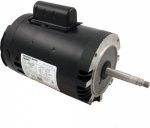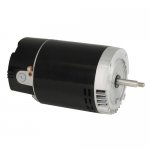- Mar 29, 2012
- 160
I'm about to replace my Polaris motor for the second time in 9 years. The first lasted 6yrs, the second a week shy of 3yrs. Both were caused by failed front bearings. I'm hoping to reduce that and/or reduce the expense, hence this post.
The first time I purchased new bearings. But after snapping off 2 of the 4 long bolts, I shelved the bearings and ordered a new motor.
This time I decided to try bearing replacement again. The long bolts came out, and the rear plate/bearing was easy on/off. The front bearing removal was a total failure, leading to a new motor. The problems I experienced were:
- Front plate (aluminum) badly corroded by salt.
- Bearing retainer plate screw corroded beyond removal. Head stripped out inside (flat) and out (hex). This meant removing the bearing with the front plate as a unit.
- Front bearing retainer plate failed (bent) while pressing off plate/bearing assembly. Bearing remained on shaft.
At this point, I gave up again. But the disassembly yielded info. Most notably that the space between the bearing and plate was filled with salt. Combined with the plate corrosion, it's obviously caused by salt water. I cannot see any visible leaking when operating or idle. And the slinger disk is in place and looks good. but obviously little drops of water are walking down the shaft and into the motor housing, killing the front bearing.
Any suggestions on prevention? I'm currently thinking about a slight forward tilt, multiple slinger discs, and maybe even manufacturing some manner of shaft seal on the motor front.
Anyone out there do an annual or semi-annual rebuild as a preventative?
The first time I purchased new bearings. But after snapping off 2 of the 4 long bolts, I shelved the bearings and ordered a new motor.
This time I decided to try bearing replacement again. The long bolts came out, and the rear plate/bearing was easy on/off. The front bearing removal was a total failure, leading to a new motor. The problems I experienced were:
- Front plate (aluminum) badly corroded by salt.
- Bearing retainer plate screw corroded beyond removal. Head stripped out inside (flat) and out (hex). This meant removing the bearing with the front plate as a unit.
- Front bearing retainer plate failed (bent) while pressing off plate/bearing assembly. Bearing remained on shaft.
At this point, I gave up again. But the disassembly yielded info. Most notably that the space between the bearing and plate was filled with salt. Combined with the plate corrosion, it's obviously caused by salt water. I cannot see any visible leaking when operating or idle. And the slinger disk is in place and looks good. but obviously little drops of water are walking down the shaft and into the motor housing, killing the front bearing.
Any suggestions on prevention? I'm currently thinking about a slight forward tilt, multiple slinger discs, and maybe even manufacturing some manner of shaft seal on the motor front.
Anyone out there do an annual or semi-annual rebuild as a preventative?





